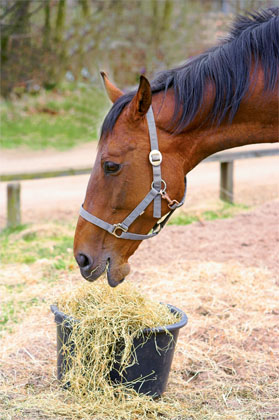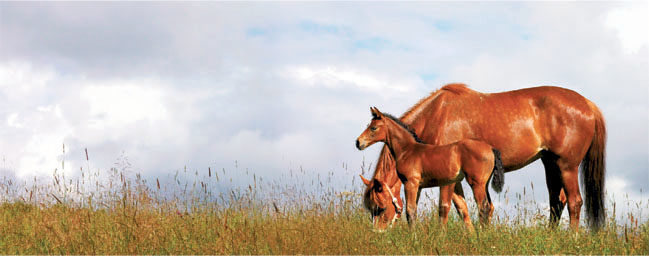It’s important for your clients to manage pastures if they want to manage horses who are susceptible to laminitis. That means controlling factors that “stress” pastures, such as drought, cold or overgrazing.
What does equine nutrition have to do with you as a farrier? After all, you don’t feed your clients’ horses; you just work on their feet.
But nutrition can have a huge impact on those feet and your work on them, especially when it comes to laminitis, and often owners just don’t know when their horse-feeding practices are contributing to the problem. You can win a lot of loyalty, and reduce your chances of working on foundered feet, by helping educate your clients about nutrition as it relates to foot health.
Nutrition was a big focus at the fourth International Equine Conference on Laminitis and Diseases of the Foot, held Nov. 2 to 4, 2007, in Palm Beach, Fla. Following are synopses of presentations on identifying horses who need nutritional changes, hay composition and growth conditions, and pasture management from Ray Geor, PhD, Paul Mellon Distinguished Professor and director of the Middleburg Agricultural Research and Extension (MARE) Center at Virginia Tech, and Kathryn Watts, owner of Rocky Mountain Research and Consulting in Center, Colo.
Which Horses Need Nutritional Management?
Insulin resistance is linked to a higher risk of laminitis, particularly pasture-associated laminitis, and obesity is known to contribute to insulin resistance. But not only fat horses — those with a high body condition score (7 to 9 on a 9-point scale) — are at risk for insulin resistance which can lead to laminitis. Researchers at Virginia Tech (VT) and elsewhere have found that limited areas of abnormal fat deposition, such as a cresty neck, may correlate to insulin resistance and laminitis more than body-wide obesity, said Geor.
“Specifically, a cresty neck score (CNS) greater than 3 (on a scale of 0 to 5, where 0 indicates no detectable crest and 5 indicates a very large crest that droops to one side of the neck) or neck circumference to height ratio (NCHR, neck circumference measured at the midpoint between the poll and withers and height measured at the withers) greater than 0.67 were associated with an increased risk of laminitis in ponies (in an unpublished study),” reported Geor.
He also noted that in another study of 258 laminitis cases at six veterinary hospitals, significantly more cases in study horses had a cresty neck than did control horses. Still more VT studies note a higher risk for pasture-associated laminitis in obese (BCS greater than 7) ponies, and a 10.4-fold increase in laminitis risk for ponies with a pre-laminitic metabolic syndrome identified by insulin resistance, a high compensatory beta-cell response, obesity and high plasma triglycerides.
Thus, both obese horses and ponies and those with regional adiposity need nutritional control to limit their weight and their insulin resistance. Geor reported that pedigree analysis of a 160-pony Welsh/Dartmoor herd at VT suggests that a pre-laminitic metabolic syndrome phenotype may be inherited via a dominant gene — although this is not yet confirmed. So offspring of horses and ponies with metabolic syndrome might also bear closer scrutiny for insulin resistance, fat accumulation and the need for dietary management, even if they aren’t overweight yet.
“The associations between insulin resistance, hyperinsulinemia, obesity and laminitis risk justify special management of insulin-resistant horses and ponies, particularly interventions that target decreased body fat mass and improved insulin sensitivity,” he concluded.
“Such interventions include a reduction in dietary energy (calories), decreased dietary starch and sugar, restricted access to pasture during high-risk periods, increased physical activity and perhaps the use of pharmacologic (e.g. levothyroxine) or nutritional agents purported to increase insulin sensitivity and/or promote weight loss.”
Sorting Out The Carbs
So how do you pick out feed and forage for high-risk horses? The jury’s still out on that. Different types of carbohydrates have been implicated as causes of laminitis, but there’s still a lot of confusion over carbs, including sugars. Why? Watts explained that this is due in part to inconsistent laboratory analysis methods and inconsistent naming conventions between researchers, laboratories and nutritionists.
“What kind of carbohydrate is most dangerous to horses with laminitis? May this differ from endocrinopathic (hormone-related) laminitis as opposed to alimentary (gut damage-related) laminitis,” she asked. “We may find out faster, and a lot of confusion would be eliminated, if plant, animal and analytical scientists would agree to use the same nomenclature, and if there was standardization in carbohydrate analytical procedures.”
High Fiber Doesn’t Guarantee Low Sugar
Often owners of horses deemed susceptible to laminitis buy mature, “stemmy” hay in hopes that its obviously higher fiber content means it has less sugars to trigger a laminitis episode. However, Watts said that this is a badly flawed approach to hay selection.
“In a plant cell, fiber and non-structural carbohydrates (NSC, including sugar, starch and fructan) do not share the same space; therefore they are not mutually exclusive,” she explained. “By definition, non-structural carbohydrates are those found inside plant cells, while fiber (structural carbohydrates including cellulose and hemicellulose) is found in cell walls. A useful analogy is a warehouse full of bins. The bins can be empty (of NSC), or the bins can be full, without changing the mass of the walls (the fiber carbohydrates).”
To prove this concept, she conducted a study that showed a correlation between neutral detergent fiber and different soluble carbohydrate fractions of -0.61 to -0.66. Thus, she concluded, if you use fiber content to pick out low-carb hay, you’d be wrong at least a third of the time.
Another study in this area involved side-by-side plantings of oat hay where one was cut in spring (some days after a freeze) and the other after a freeze in late-growth stages. The late-cut hay contained as much NSC (30%) as the hay cut in the early boot stage, despite having around 20% more fiber.
“Choosing hay for horses with insulin resistance requires that sugar and starch content of hay be measured directly,” Watts stated. “NSC concentration cannot be accurately inferred from fiber content.”
Watts has also conducted studies showing that up to 55% of NSC can be pulled out of some hays through water soaking.
Managing Pastures And Pastured Horses
The take-home message of Watts’ discussion of pastures is that stressed pasture will stress a horse who is susceptible to laminitis. It doesn’t matter what the stress is — drought, cold, lack of nutrients, etc. — because any stress will impair the plant’s ability to grow new plant tissue. Thus, carbohydrates from photosynthesis will build up, becoming more and more concentrated, until the plant is able to use them for new plant tissue.
It follows that neglecting pasture carries more risk of triggering laminitis than taking good care of it. For example, overgrazing promotes survival of hardier, higher-sugar plants and weeds, and it forces horses to eat the higher-sugar stems (stem bases are higher in sugar than leaves). So the horse might eat less overall, but what he does eat will be higher in sugar.
To get lower-sugar pasture plants, Watts recommended maintaining good watering and fertilization practices, and mowing pastures when seed heads just start to poke out to promote leafy tissue, which is lower in sugar than seed heads or stems. Graze these pastures 2 to 3 weeks after mowing.

Careful selection of hay is important for managing horses who are susceptible to laminitis. But some horse owners buy high-fiber hay in the belief that it will be low in sugars. In fact, says Kathryn Watts, high-fiber hay can still be high in non-structural carbohydrates, which include sugars.
Controlling high-sugar weeds such as dandelion, plantain, sowthistle or redstem fillaree with herbicides is also important. (Watts uses Cimarron by DuPont, which she says is a good broad-spectrum broadleaf herbicide with a zero grazing day interval and less environmental impact than some other herbicides.)
To maintain low-sugar pastures, you have to learn to be an excellent grazing manager, she said.
Last but certainly not least, she emphasized that environmental conditions such as cold and drought stress will raise sugar concentrations despite one’s best efforts. The best strategy in this scenario is to limit or remove all grazing time for high-risk horses.
Domestic Diets Vs. Feral Forage
Nutrition researchers have joined in the trend of comparing domestic and wild horse environments in search of what’s healthier for horses.
Watts presented the results of a study comparing nutrient composition of wild horse forages (the same species eaten by mustangs on the Pryor Mountain Wild Horse Range in Montana and Wyoming) to that of introduced, improved grasses collected under similar environmental conditions. Here’s what she observed:
- Native shrubs eaten by feral horses contained 12% to 13% crude protein (on a dry matter basis) and “good” levels of major and trace minerals.
- Copper and zinc levels were higher than that of local cultivated grass hay.
- Native and naturalized forages are lower in NSC than “improved” species commonly planted for horse hay and pasture. Most species were less than 12% NSC, and many were less than 9% NSC — even in early growth and under cold stress. Average pasture grass was 15% to 18% DM and often was over 20% NSC under similar growing conditions.
- Native grasses tend to grow in bunches, with bare ground between them. This lowers the amount of nutrition per acre, requiring wild horses to exercise more than domestic horses to get enough to eat.
- In winter, when horses aren’t breeding or feeding foals, nutrient value of native forages decreases. Humans feed hay cut at maximum nutrient density through the winter, removing this seasonal variation in diet.








Post a comment
Report Abusive Comment